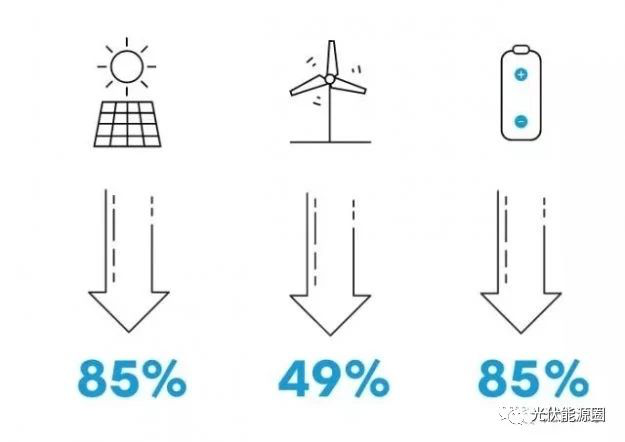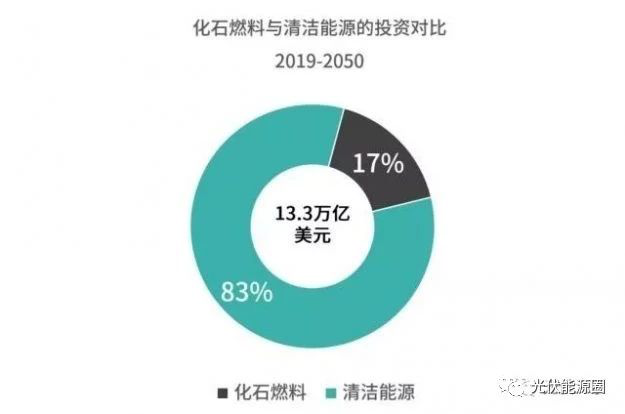
According to analysis, in the next 30 years, 4.2 trillion US$ of capital will flow to the PV industry, while China will become the largest wind-power and photoelectricity market. By 2050, the share of the two parts in the power market will rise from the current 8% to 48%, bringing a big PV market!
From the data of global PV installed capacity, 2018 is a year to remember for two reasons: Firstly, in 2018, the global PV installed capacity broke through the threshold of 100GW for the first time, reaching 102.4GW; Secondly, the growth rate in this year is only 4%, far lower than 50% in 2016 and 30% in 2017.
However, it looks like a “short break” before the next stage of growth.
According to the latest forecast of Bloomberg New Energy Finance (BNEF), in the coming 30 years, the share of solar energy in the global energy market will surge and it will attract more than 4.2 trillion US$ of investment.
An Opportunity Worth of 4.2 Trillion Dollar
Every year, BNEF will make a report named New Energy Outlook (NEO) by analyzing the energy situation of each country.
NEO 2019 shows that since 2010, the cost of solar energy, wind energy and batteries has been declining.

The declining cost of solar energy, wind energy and batteries since 2010.
Source:BNEF
One result of this trend is that in about two-thirds of the world, photoelectricity and wind power are the options with the lowest cost to increase power capacity, attracting massive investment.
Between 2018 and 2050, global electricity demand will rise by 62%. To meet the demand, the global power capacity should be three times higher than what it is today, which will bring $13.3 trillion of new investment to the energy industry.
83% of the investment will flow into the part of clean energy, of which $5.3 trillion for wind energy and $4.2 trillion for solar energy. Besides, the grid expansion and battery industry will attract $11.4 trillion and $840 billion of investment respectively.

83% of the investment will flow into the part of carbon-free energy.
Source:BNEF

$5.3 trillion of investment for wind energy and $4.2 trillion for solar energy.
Source:BNEF
According to BNEF's analysis of comprehensive technology trends and energy costs, by 2050, the share of coal power in the global energy market will fall from the current 37% to 12%, and oil-fired power will almost disappear. Wind energy and luminous energy will rise from the current 7% to 48% in 2050, while the proportion of hydro, natural gas and nuclear energy will fluctuate around 1%.
Matthias Kimmel, the principal analyst of NEO 2019, said that compared with the report results in recent years, it can be concluded that the manufacturing costs of PV modules, turbines and lithium batteries still have a significant space to decline. For every doubling of global installed capacity, their costs will fall by 28%, 14% and 18% respectively.
By 2030, the price of electricity produced, stored and transported by these three parts will lower than the current price of thermal power.
China: Leading Low Carbon Economy
China has played an indispensable role among all the changes mentioned above.
In a recent article, the Financial Times said that without China's exploitation of wind and solar energy in the past 10 years, the production of renewable energy will not increase like that while the transition to the low-carbon economy will hardly begin.
Currently, solar and wind energy can compete with other kinds of energy without any subsidies, largely because of the large-scale production of turbines and battery panels by Chinese companies. According to data from the investment bank Lazard, in the past ten years, the cost of wind power and solar power have fallen by 69% and 88% respectively.
With declining cost, now PV power generation industry has been able to compete in the market without any subsidy.
China, the Global Leader of These Two Technologies
It can be concluded that China is leading the transition of energy. It is far more than that. China is far ahead of other countries in developing and applicating advanced grid technology. It’s also the world's largest producer of lithium-ion batteries, accounting for about 60% of global production capacity.
Last year, the number of civilian nuclear power plants installed by Chinese companies were more than any other country’s. There are currently 3 million electric vehicles being used around the world, most of which are in China – the sales amount in the country accounts for 56% of total electric vehicle sales last year.
China will also become the largest market for wind power and PV. By 2050, the proportion of these two parts in the power market will rise from the current 8% to 48%. China's energy emissions will at its peak in 2026, and fall by half in the following 20 years.
By 2050, Asia's electricity demand will more than double. For meeting such demand, energy investment in the Asia-Pacific region needs to reach 5.8 trillion US$, of which China and India add up to exceed 4.3 trillion US$.
Energy Reform is Driving Low-carbon Economy
If the development of renewable energy is as predicted by NEO 2019, it’s possible to achieve the goal set out in the Paris Agreement, constraining the average increase of global temperature in this century within 2 degrees Celsius.
Moreover, it’s no longer necessary for national governments to provide subsidies for wind power and photoelectricity industry in the next 10-15 years. “The era of providing subsidy for the new energy industry is coming to an end,” said Elena Giannakopoulou, chief economist at BNEF. “But the government should reform the energy market to ensure a fair chance for photoelectricity and wind power to compete.”
Of course, it’s not enough to meet the goals of the Paris Agreement if relying on the technological advances in solar, wind and battery alone.
By the middle of this century, the use of wind and solar energy will account for more than 80% in most countries; however, the achievement of the goal should be assisted by other technologies, such as nuclear energy, biomass power generation, and carbon capture.
Therefore, BNEF suggested that national governments need to make efforts in two aspects: on the one hand, ensure a friendly market for low-cost wind power and photoelectricity by policy reforms; on the other hand, ensure the progress of low-carbon targets by deploying necessary technologies in advance.
Both the general trend of the low-carbon economy and the leap of clean energy technology points to a promising future. In the 30 years from now, the proportion of clean energy such as PV in the global energy industry will continue to increase, and China will be the leader of this leap.
To explore the tremendous market, the 11th Guangzhou International Solar Photovoltaic Exhibition (PV Guangzhou 2019) will be held this August 16th-18th. More information about the expo, please contact us.


